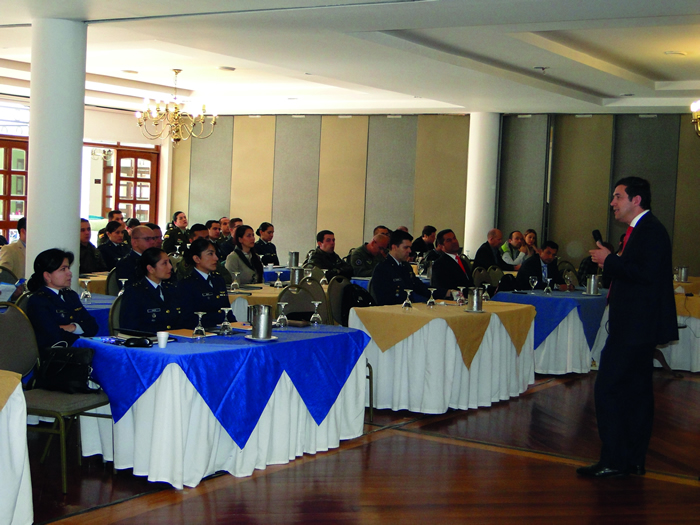Current status and prospects of the persecution of child recruiters: the Colombian case
DOI:
https://doi.org/10.18667/cienciaypoderaereo.423Keywords:
Armed Conflict, Forced Recruitment, Children and Adolescents, VictimsAbstract
The purpose of this work is to acknowledge the dispositions that would be applicable to the perpetrators of child recruitment in the Colombian armed conflict, observing (i) the dynamics of child recruitment in the country, (ii) the international law, (iii) the national law, and (iv) relevant global trends. On the basis of documentary work, it was found that the nature of the crime of child recruitment, the growing global demands on its punishment and the adoption of tough dispositions in the national legislation, clear the way for the prosecution of perpetrators. Other remarked findings are these two identified trends: (i) both in the national and the international scenes, it is widely accepted that the age of 18 (opposed to the 15 years old previous disposition) is the minimum for being protected against child recruitment; and (ii) amnesties granted within transitional justice processes are increasingly and decidedly excluding serious crimes, like child recruitment.
Downloads
References
Bakker, C. Prosecuting international crimes against children: the legal framework. UNICEF, Innocenti Research Centre. Florencia: UNICEF.
Bakker, C., & Greijer, S. (2009). Children's rights: the potential impact of private military and security companies. European University Institute. Florencia: Academy of European Law.
Bjørkhaug, I. (2010). Child soldiers in Colombia: the recruitment of children into non- state violent armed groups. University of Sussex, Institute of Development Studies. Brighton: MICROCON Research Working Paper 27.
https://doi.org/10.2139/ssrn.1650250
Guáqueta, A. (2006). Operando en medio del conflicto: construcción de paz y algunas mejores prácticas de empresas colombianas. Fundación Ideas para la Paz, Serie Working Papers FIP - No 2. Bogotá: FIP.
Herencia Carrasco, S. (2010). Transitional Justice and the situation of children in Colombia and Peru. UNICEF, Innocenti Research Centre. Florencia: UNICEF.
Ortega-Jurado, M. (2012). Protección de la infancia y adolescencia en asuntos de Derecho Internacional Humanitario en Colombia. Revista Colombiana de Derecho Internacional (20), 17-50.
Ramírez Barbosa, P. A. (2010). El reclutamiento de menores en el conflicto armado colombiano. Aproximación al crimen de guerra. Revista Derecho Penal y Criminología , XXXI (90), 115-136.
Revelo Hernández, M. F. (2010). Los niños de la guerra: resultados, mapas de vulnerabilidad, riesgo y oportunidad. Revista Unimar (56), 61-78.
Springer, N. (2012). Como corderos entre lobos. Del uso y reclutamiento de niñas, niños y adolescentes en el marco del conflicto armado y la criminalidad en Colombia. Centro de Memoria Histórica. Bogotá: Springer Consulting Services.
Velasco Sotelo, F. A., & García Molano, C. A. (2013). Menores desmovilizados de los grupos armados víctimas del conflicto. Bogotá, Colombia: Universidad Militar Nueva Granada.

Downloads
Published
Issue
Section
License
Assignment of Copyrights
Authors assign Ciencia y Poder Aéreo journal the exclusive rights (reproduction, distribution, public communication, and transformation) to exploit and commercialize their work, in whole or in part, in all the formats and modalities of present or future exploitation, in all languages, throughout the life of the work and throughout the world.
All contents published in Ciencia y Poder Aéreo journal are licensed under a Creative Commons Attribution 4.0 International License, whose complete information is available at http://creativecommons.org/licenses/by/4.0/
Under the terms of this license, users are free to download, print, extract, archive, distribute and publicly communicate the content of articles, provided that proper credit is granted to authors and Ciencia y Poder Aéreo, scientific journal of the Graduate School of the Colombian Air Force. Except when otherwise indicated, this site and its contents are licensed under a Creative Commons Attribution 4.0 International License.
For other uses not considered under this license it is required to contact the Director or the Editor of the journal at the e-mail address cienciaypoderaereo1@gmail.com.
The Graduate School of the Colombian Air Force and this publication are not responsible for the concepts expressed in the articles, including the metadata or the affiliation stated by authors. This is the full responsibility of the authors.





















